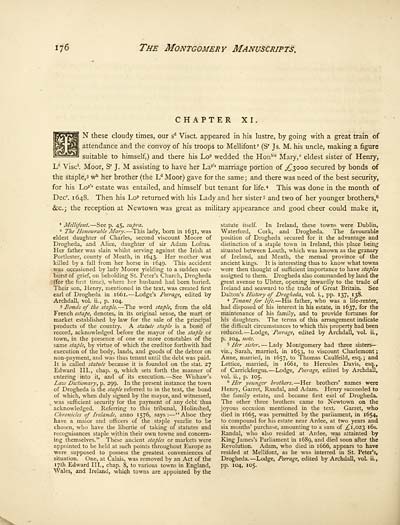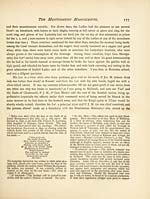Montgomery manuscripts
(190) Page 176
Download files
Complete book:
Individual page:
Thumbnail gallery: Grid view | List view

176
The Montgomery Manuscripts.
chapter XI.
N these cloudy times, our s d Visct. appeared in his lustre, by going with a great train of
attendance and the convoy of his troops to Mellifont 1 (S r Js. M. his uncle, making a figure
suitable to himself,) and there his Lo p wedded the Hon ble Mary, 2 eldest sister of Henry,
L d Vise'. Moor, S r J. M assisting to have her La p ' ii marriage portion of .£3000 secured by bonds of
the staple^ w h her brother (the L d Moor) gave for the same; and there was need of the best security,
for his Lo p ' s estate was entailed, and himself but tenant for life. 4 This was done in the month of
Dec'. 1648. Then his Lo p returned with his Lady and her sisters and two of her younger brothers, 6
&c; the reception at Newtown was great as military appearance and good cheer could make it,
" Mellifont. — See p. 45, supra.
" The Honourable Mary. — This lady, born in 1 63 1, was
eldest daughter of Charles, second viscount Moore of
Drogheda, and Alice, daughter of sir Adam Loftus.
Her father was slain whilst serving against the Irish at
Portlester, county of Meath, in 1643. Her mother was
killed by a fall from her horse in 1649. This accident
was occasioned by lady Moore yielding to a sudden out-
burst of grief, on beholding St. Peter's Church, Drogheda
(for the first time), where her husband had been buried.
Their son, Henry, mentioned in the text, was created first
earl of Drogheda in 1 66 1. — Lodge's Peerage, edited by
Archdall, vol. ii., p. 104.
3 Bonds of the staple. — The word staple, from the old
French estape, denotes, in its original sense, the mart or
market established by law for the sale of the principal
products of the country. A statute staple is a bond of
record, acknowledged before the mayor of the staple or
town, in the presence of one or more constables of the
same staple, by virtue of which the creditor forthwith had
execution of the body, lands, and goods of the debtor on
non-payment, and was thus tenant until the debt was paid.
It is called statute because it is founded on the stat. 27
Edward HI., chap. 9, which sets forth the manner of
entering into it, and of its execution. — See Wishaw's
Law Dictionary, p. 299. In the present instance the town
of Drogheda is the staple referred to in the text, the bond
of which, when duly signed by the mayor, and witnessed,
was sufficient security for the payment of any debt thus
acknowledged. Referring to this tribunal, Holinshed,
Chronicles of Irelande, anno 1576, says: — "Alsoe they
have a maior and officers of the staple yearlie to be
chosen, who have the libertie of taking of statutes and
recognisances staple within their own towne and concern-
ing themselves." These ancient staples or markets were
appointed to be held at such points throughout Europe as
were supposed to possess the greatest conveniences of
situation. One, at Calais, was removed by an Act of the
17th Edward III., chap. 8, to various towns in England,
Wales, and Ireland, which towns are appointed by the
statute itself. In Ireland, these towns were Dublin,
Waterford, Cork, and Drogheda. The favourable
position of Drogheda secured for it the advantage and
distinction of a staple town in Ireland, this place being
situated between Louth, which was known as the granary
of Ireland, and Meath, the mensal province of the
ancient kings. It is interesting thus to know what towns
were then thought of sufficient importance to have staples
assigned to them. Drogheda also commanded by land the
great avenue to Ulster, opening inwardly to the trade of
Ireland and seaward to the trade of Great Britain. See
Dalton's History of Drogheda, vol. i., pp. 137, 138.
4 Tenant for life. — His father, who was a life-renter,
had disposed of his interest in his estate, in 1637, for the
maintenance of his family, and to provide fortunes for
his daughters. The tenns of this arrangement indicate
the difficult circumstances to which this property had been
reduced. — Lodge, Peerage, edited by Archdall, vol. ii.,
p. 104, note.
5 Her sister. — Lady Montgomery had three sisters—
viz., Sarah, married, in 1653, to viscount Charlemont ;
Anne, married, in 1657, to Thomas Caulfeild, esq.; and
Lettice, married, in 1661, to Hercules Davis, esq.,
of Carrickfergus. — Lodge, Peerage, edited by Archdall,
vol. ii., p. 105.
6 Her younger brothers. — Her brothers' names were
Henry, Garret, Randal, and Adam. Henry succeeded to
the family estate, and became first earl of Drogheda.
The other three brothers came to Newtown on the
joyous occasion mentioned in the text. Garret, who
died in 1665, was permitted by the parliament, in 1654,
to compound for his estate near Ardee, at two years and
six months' purchase, amounting to a sum of ,£1,023 16s.
Randal, who also resided at Ardee, was attainted by
King James's Parliament in 1689, and died soon after the
Revolution. Adam, who died in 1666, appears to have
resided at Mellifont, as he was interred in St. Peter's,
Drogheda. — Lodge, Peerage, edited by Archdall, vol. ii.,
pp. 104, 105.
The Montgomery Manuscripts.
chapter XI.
N these cloudy times, our s d Visct. appeared in his lustre, by going with a great train of
attendance and the convoy of his troops to Mellifont 1 (S r Js. M. his uncle, making a figure
suitable to himself,) and there his Lo p wedded the Hon ble Mary, 2 eldest sister of Henry,
L d Vise'. Moor, S r J. M assisting to have her La p ' ii marriage portion of .£3000 secured by bonds of
the staple^ w h her brother (the L d Moor) gave for the same; and there was need of the best security,
for his Lo p ' s estate was entailed, and himself but tenant for life. 4 This was done in the month of
Dec'. 1648. Then his Lo p returned with his Lady and her sisters and two of her younger brothers, 6
&c; the reception at Newtown was great as military appearance and good cheer could make it,
" Mellifont. — See p. 45, supra.
" The Honourable Mary. — This lady, born in 1 63 1, was
eldest daughter of Charles, second viscount Moore of
Drogheda, and Alice, daughter of sir Adam Loftus.
Her father was slain whilst serving against the Irish at
Portlester, county of Meath, in 1643. Her mother was
killed by a fall from her horse in 1649. This accident
was occasioned by lady Moore yielding to a sudden out-
burst of grief, on beholding St. Peter's Church, Drogheda
(for the first time), where her husband had been buried.
Their son, Henry, mentioned in the text, was created first
earl of Drogheda in 1 66 1. — Lodge's Peerage, edited by
Archdall, vol. ii., p. 104.
3 Bonds of the staple. — The word staple, from the old
French estape, denotes, in its original sense, the mart or
market established by law for the sale of the principal
products of the country. A statute staple is a bond of
record, acknowledged before the mayor of the staple or
town, in the presence of one or more constables of the
same staple, by virtue of which the creditor forthwith had
execution of the body, lands, and goods of the debtor on
non-payment, and was thus tenant until the debt was paid.
It is called statute because it is founded on the stat. 27
Edward HI., chap. 9, which sets forth the manner of
entering into it, and of its execution. — See Wishaw's
Law Dictionary, p. 299. In the present instance the town
of Drogheda is the staple referred to in the text, the bond
of which, when duly signed by the mayor, and witnessed,
was sufficient security for the payment of any debt thus
acknowledged. Referring to this tribunal, Holinshed,
Chronicles of Irelande, anno 1576, says: — "Alsoe they
have a maior and officers of the staple yearlie to be
chosen, who have the libertie of taking of statutes and
recognisances staple within their own towne and concern-
ing themselves." These ancient staples or markets were
appointed to be held at such points throughout Europe as
were supposed to possess the greatest conveniences of
situation. One, at Calais, was removed by an Act of the
17th Edward III., chap. 8, to various towns in England,
Wales, and Ireland, which towns are appointed by the
statute itself. In Ireland, these towns were Dublin,
Waterford, Cork, and Drogheda. The favourable
position of Drogheda secured for it the advantage and
distinction of a staple town in Ireland, this place being
situated between Louth, which was known as the granary
of Ireland, and Meath, the mensal province of the
ancient kings. It is interesting thus to know what towns
were then thought of sufficient importance to have staples
assigned to them. Drogheda also commanded by land the
great avenue to Ulster, opening inwardly to the trade of
Ireland and seaward to the trade of Great Britain. See
Dalton's History of Drogheda, vol. i., pp. 137, 138.
4 Tenant for life. — His father, who was a life-renter,
had disposed of his interest in his estate, in 1637, for the
maintenance of his family, and to provide fortunes for
his daughters. The tenns of this arrangement indicate
the difficult circumstances to which this property had been
reduced. — Lodge, Peerage, edited by Archdall, vol. ii.,
p. 104, note.
5 Her sister. — Lady Montgomery had three sisters—
viz., Sarah, married, in 1653, to viscount Charlemont ;
Anne, married, in 1657, to Thomas Caulfeild, esq.; and
Lettice, married, in 1661, to Hercules Davis, esq.,
of Carrickfergus. — Lodge, Peerage, edited by Archdall,
vol. ii., p. 105.
6 Her younger brothers. — Her brothers' names were
Henry, Garret, Randal, and Adam. Henry succeeded to
the family estate, and became first earl of Drogheda.
The other three brothers came to Newtown on the
joyous occasion mentioned in the text. Garret, who
died in 1665, was permitted by the parliament, in 1654,
to compound for his estate near Ardee, at two years and
six months' purchase, amounting to a sum of ,£1,023 16s.
Randal, who also resided at Ardee, was attainted by
King James's Parliament in 1689, and died soon after the
Revolution. Adam, who died in 1666, appears to have
resided at Mellifont, as he was interred in St. Peter's,
Drogheda. — Lodge, Peerage, edited by Archdall, vol. ii.,
pp. 104, 105.
Set display mode to:
![]() Universal Viewer |
Universal Viewer | ![]() Mirador |
Large image | Transcription
Mirador |
Large image | Transcription
Images and transcriptions on this page, including medium image downloads, may be used under the Creative Commons Attribution 4.0 International Licence unless otherwise stated. ![]()
| Histories of Scottish families > Montgomery manuscripts > (190) Page 176 |
|---|
| Permanent URL | https://digital.nls.uk/95235207 |
|---|
| Description | A selection of almost 400 printed items relating to the history of Scottish families, mostly dating from the 19th and early 20th centuries. Includes memoirs, genealogies and clan histories, with a few produced by emigrant families. The earliest family history goes back to AD 916. |
|---|

